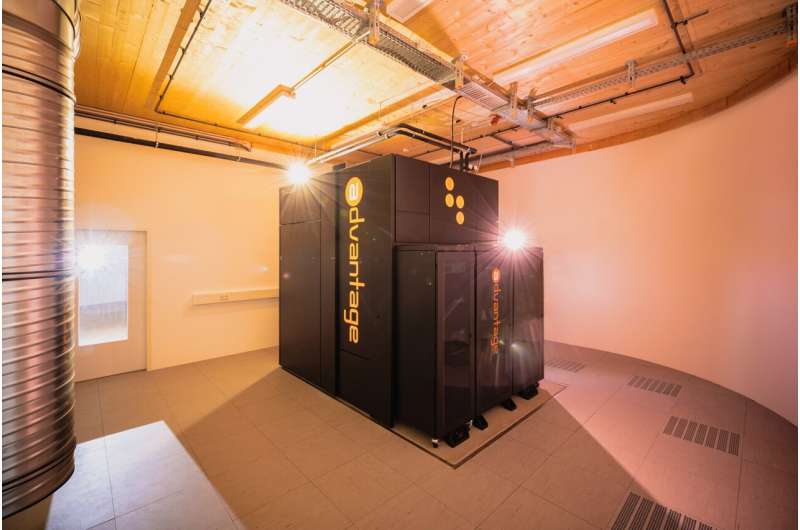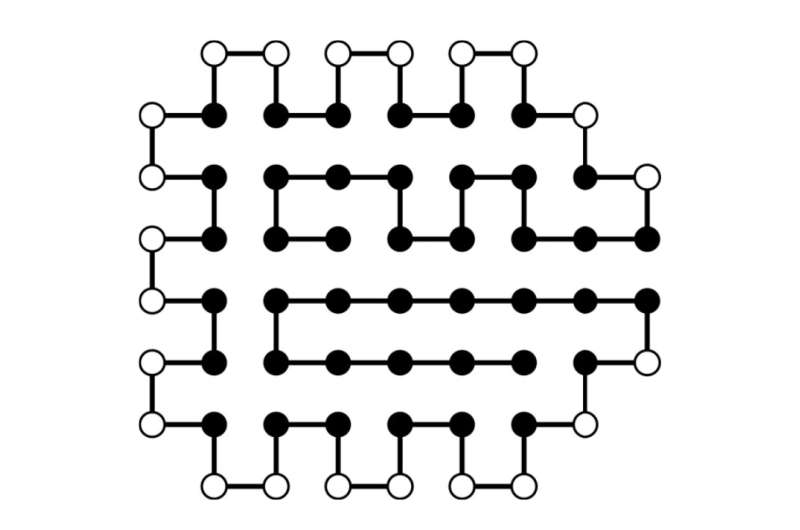Quantum computers solve protein puzzles


The JUPSI D-wave quantum incubator of the JUNIQ quantum computing infrastructure at Forschungszentrum Jülich. Credit: Forschungszentrum Jülich / Sascha Kreklau
Dr. Sandipan Mohanty, physicist and code expert, has been working on molecular biology simulations for the world’s fastest supercomputers for 20 years. Such simulations help unravel the building blocks of life and provide new insights into the cellular machinery.
Together with researchers at Sweden’s Lund University, he has now gone a step further and brought the problem of protein folding into a quantum computer. D-Wave’s JUPSI Quantum Incubator of the JUNIQ quantum computer user base at Forschungszentrum Jülich has more than 5,000 qubits and is the first of its size outside of North America. In an interview, Sandipan Mohanty offers insight into pioneering work.
What is your mission, Dr. Sandipan Mohanty?
I’d say what we’ve actually achieved is to show the viability of quantum computers to non-trivial research questions in our field. Quantum computers are a fairly new technology, and it’s still unclear how to program them when you’re trying to solve real science tasks with these new machines. For example, it is quite different from classic high-performance computing problem solving.
More specifically, we have successfully studied protein folding using a very simple model. Protein is an important building block of life. They complete a variety of tasks. These include, for example, the transport of substances and cellular structures. And they can only fulfill all of these functions if they have a very specific form, which they achieve through a process called protein folding.
One of the many reasons why there is so much interest in this process is the link between neurodegenerative diseases such as Alzheimer’s disease or Parkinson’s disease with protein misfolding. Our hope is that quantum computers will have important advantages that will further advance our understanding of such phenomena.
Why is protein folding so computationally intensive?
Proteins are long flexible chains of Amino Acids. An intriguing property of these molecules is that most proteins naturally clump together into very specific three-dimensional shapes when you place them in a solution, such as water. So in principle, all you need to know is amino acid sequence make a protein chain. The chain will then automatically know what shape it should fold into.
When modeling this folding process on a computer, there is a lot to try. You can think of it like trying to calculate all the different ways you could arrange a necklace, to find the “best” arrangement. Furthermore, checking each arrangement is also computationally expensive due to the large number of particles involved. Typically, this means millions of interactions that require computation for every checked arrangement.

Example of the calculated structure of a sequence with the lowest energy 64 amino acids known. The filled and open symbols denote hydrophobic (H) and water-soluble/polar (P) elements as H and P respectively. Credit: A. Irbäck et al., Phys. Rev. Research, DOI: 10.1103/PhysRevResearch.4.043013 (CC BY 4.0)
How do quantum computers work compared to classical digital computers?
The task we solved is many years more complex than the problems we normally solve with classical supercomputers, where large-scale detailed atomic simulations are common. On the D-Wave machine, we used a very small HP model. This simplifies the problem massively, retaining only the minimal essential physical properties of the folding process. We ignore the surroundings, just divide amino acids into two categories, approximating each amino acid by a sphere that can occupy only positions on the lattice.
I should point out that to this day, even with such simplified models, being able to study sequences of 64 amino acids using quantum computers is a difficult problem, which makes our results Very pleased!
The corresponding simulation can also be performed in a classical fashion. A manual is enough for this. The calculation time is not much different, in both cases it takes between one and two minutes. However, this value is actually meaningless. Much more important is the quality of the results. And here, the quantum annealing machine clearly performs better.
It is quite easy to achieve a 100 percent success rate in finding the lowest energy structure on JUPSI. On the other hand, with classical computers, comparative simulations achieved only 80% for sequences of 30 amino acids. For more complex proteins consisting of 48 or 64 amino acid blocks, they perform much worse, while the quantum incubator always produces accurate results here.
Why are quantum computers here more accurate than classical computers?
Because it benefits from specific aspects of the research problem. The computational effort required with classical computers, to account for all relevant protein profiles, is astronomically high. It grows exponentially with the length of the protein chain. With a string of two beads, there can be ten possibilities. With three beads, there were a hundred. But with 100 beads—still quite a bit for a protein—one would have to calculate variations billions of times more than the number of atoms in the universe.
To perform any meaningful calculation, a lot of tricks are used. Our team at Joint Stock Company and my collaborators in Sweden both specialize in so-called Monte Carlo simulations. This is a procedure based on statistical physics and random sampling. Although infinitely long simulations are guaranteed to produce accurate results, short runs can have large errors. In practice, one tries to make simulations “long enough”, such that small estimation errors are tolerable. This is the advantage of the quantum incubator.
This machine can, if programmed correctly, perform this approximation very directly through its quantum mechanical couplings. It’s basically a kind of complex physics experiment that automatically solves equations. In our problem it seemed to have the effect that a relatively smaller runtime was required to get a very good answer. However, the fact that it worked so well in practice surprised us a bit.
What perspective applications does this currently open up for quantum computers?
Our work only marks a first step. Most quantum computers today have only a few qubits. The D-Wave system has 5000, which is a lot. But for most research problems, efficient applications of quantum computers will require even more qubits. We are still a long way from simulations like those used in drug research being done on supercomputers. I think we will have to wait two or three more generations of devices before we can solve such problems on a quantum basis. computer.
But I hope. Contrary to the existing research that we have learned from that, our formula remains simple when increasing the system size. This opens up a potentially smoother avenue for studying significantly more complex problems on quantum computers.
Provided by
Forschungszentrum Juelich
quote: Quantum computer solves protein puzzle (2023, Jan 19) taken Jan 19, 2023 from https://techxplore.com/news/2023-01-quantum-protein-puzzle.html
This document is the subject for the collection of authors. Other than any fair dealing for private learning or research purposes, no part may be reproduced without written permission. The content provided is for informational purposes only.


